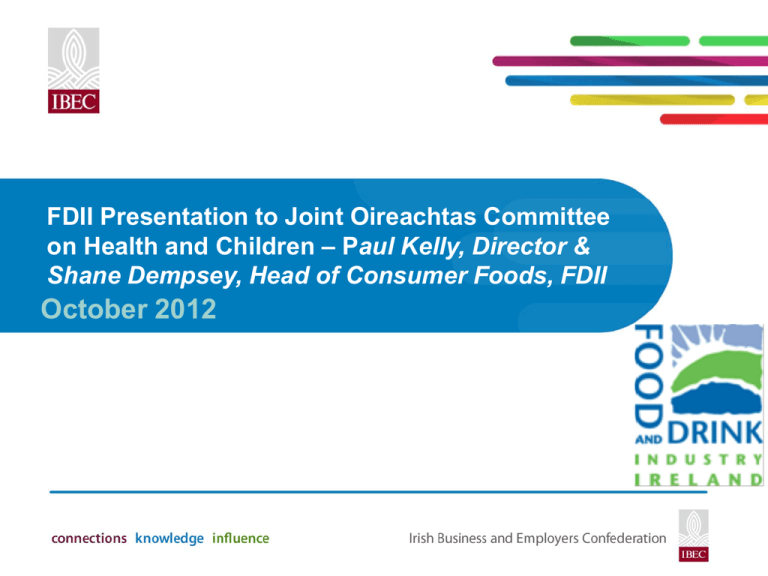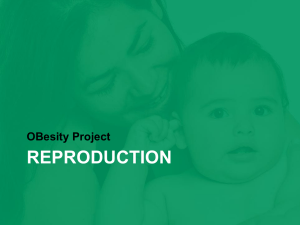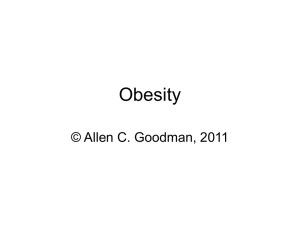FDII presentation to the Joint Oireachtas Committee on Health and
advertisement

FDII Presentation to Joint Oireachtas Committee on Health and Children – Paul Kelly, Director & Shane Dempsey, Head of Consumer Foods, FDII October 2012 The Irish Agri-food sector 1 in 8 jobs in the Irish economy are dependent on the sector Employs 50,000 directly, 60,000 indirectly and support 120,000 farming families 690 enterprises (94% are SMEs) Supplies the majority of Ireland’s €14bn grocery sector €9bn exports in 2011, target of €12bn by 2020 2/3 of indigenous exports €11.5bn purchases in the domestic economy Purchases 90% of Ireland’s agricultural output brand and reputation are key to our past and future success – must be protected Food industry’s Commitment Food industry takes its responsibility seriously Reformulation (80% of members) Increasing choice/options for consumers Nutrition information on pack: GDAs Compliance marketing and advertising codes guidelines Funding healthy initiatives Engaging with state agencies and EU bodies such as the EU Platform Reformulation efforts A survey carried out by FDII in 2012 into member’s reformulation and choice initiatives over the last three years showed: - 82% of respondents had reformulated their products - 76% had reduced salt in their products - 50% had reduced saturated fat in their product - 58% had reduced sugar in their products - 60% launched ‘alternative’ products - 83% of companies advertise these ‘alternative’ products - 68% have portions size information on their products - 46% have introduced reduced portion versions of their products - FSAI reported that trans fats levels within the population are within dietary guidelines Solving obesity requires a ‘whole of society’ response FDII is asking Government to build a collaborative platform with industry to address this issue - Livewell Project We believe that working together all stakeholders make a bigger impact in reducing obesity Food companies have a strong track record in taking individual and collective actions in the health area eg salt reduction Requests that obesity related policies are evidence-based, part of a holistic response and do not damage the food sector or disproportionately target particular categories IUNA data should from the basis of future solution Livewell Initiative: Pillars FDII’s Livewell Platform All members sign-up to overarching platform pledge PILLAR 1: REFORMULATION & CHOICE PILLAR 2: NATIONAL WORKPLACE WELL-BEING PILLAR 3: RESEARCH PILLAR 4:CATEGORY COMMITMENTS Companies provide info on reformulation activities: NHF carrying out a root and branch of their WWB material Salt, Sugar, Sat/Trans Fats, Additives, fortification, choice and portion size An enhanced WWB campaign will be rolled out nationally in 2013/14 FDII will engage research institution to research how to increase physical activity levels in primary schools and formulate a health literacy campaign FDII will work with product associations to identify relevant initiatives that can be incorporated into Livewell Information is collated on a category basis Information made public to FSAI NHF are engaging with IBEC to ensure that WWB is promoted through its membership. Eg BCI have created a policy on vending machines in secondary schools FDII aims to select a sample of text companies in the public, private and SME sector to roll out interventions amongst the workforce Information reported on a yearly basis FSAI evaluates progress on a yearly basis Livewell Steering committee will create a series of health metrics to measure the WWB impact on target employees The metrics committee will establish health metrics to measure impact amongst target groups FDII will engage IBEC’s IR/HR division to establish employment metrics to measure impact of the WWBC Market Research company will identify and measure attitudes and behaviours nationally and amongst target populations Once identified, these initiatives can have metrics created for their measurement Solutions: What the experts say Childhood obesity is a hugely complex multi-faceted problem that requires a ‘whole of society’ response “The scale of the challenge to prevent obesity is magnified by the complex nature of the condition. The multiplicity of causes of obesity argues against a dependence on fragmented solutions to address the issue; and too heavy a focus on one part of the obesity system – on one population group, for example – is not likely to bring about the scale of change required.” –Foresight Report, 2008 John Dalli Member of the European Commission, responsible for Health and Consumer Policy: None of us, however, is able to reverse the obesity trend in isolation. We need to work together: policy makers, educators, universities, healthcare professionals, civil society, and industry. Developing effective partnerships is key. It’s important to work with industry to tackle obesity/need for an integrative solution to the problem with the Government, industry and individuals having a role – Professor Donal O’Shea Obesity Map Factors affecting obesity at individual level Principles of a solution The following principles are consistently advocated by experts including many who have attended this committee: - Strategy for societal response required - Harnessing all stakeholders - Industry is an effective partner but can’t operate as a scapegoat - Interventions should be long-term and sustained - Targeted at ‘risk’ groups - Broad national policies can increase inequality - For childhood obesity, early interventions aimed at prevention are key - physical activity has a major role to play - information and education are key Reformulation case study: Salt Reduction Food companies are constantly reformulating products based on scientific advice, in addition to increase ranges and portion sizes of products for consumers In 2004, FSAI and FDII began work on salt-reduction initiatives across the industry Some average reductions: Category Reduction Bread - 20% Soups and Sauces -25% in some categories Breakfast Cereals -48% since 1998 Snack Foods -19% in crisps GDAs Industry’s Positive Initiatives: GDA Labelling Since 2006, FDII involved in initiative to place GDAs on labelling and spent €400K in 2008/9 on public awareness FSAI survey 2009 showed consumers preferred GDA Penetration 95% own brand, 83% on branded goods Food Advertising/Marketing to Children Steps taken to reduce ‘exposure’ voluntarily – exposure during children’s programmes on Irish TV from 36% to 7% Over 98% compliance with existing BAI and ASAI guidelines and internal codes Many FDII members are committed to the EU advertising pledge – Ireland has nearly 100% compliance across media FDII engaging with BAI to try to create an advertising model that is suitable the Irish population’s health profile Vending Machines There are no vending machines in primary schools Established guidelines for vending machines in secondary schools in 2005 All relevant FDII members compliant with guidelines Installation of vending machines and product-mix are school-led Members consult with school management in stocking products Majority of schools stocked by 3rd party vendors Taxation: Affects wealth not health Taxation is regressive Marginal impacts on diets (Tiffin 2012) Food taxation rejected in Denmark and Italy Ireland has high rate of tax on soft drinks: VAT 23% Contribution of soft drinks to calorie intake is 2-3% 60% of Irish population don’t consume soft drinks Measure will be viewed as a ‘stealth tax’ Unproven in reducing obesity Summary FDII respectfully requests that this committee: - - recommends that Government leads a whole of society approach to childhood obesity engages with industry’s proposed Livewell Project as part of this response avoids policies that are not evidence-based and target food companies Education and information must be the basis for policy interventions Irish food companies are ready to play their part









